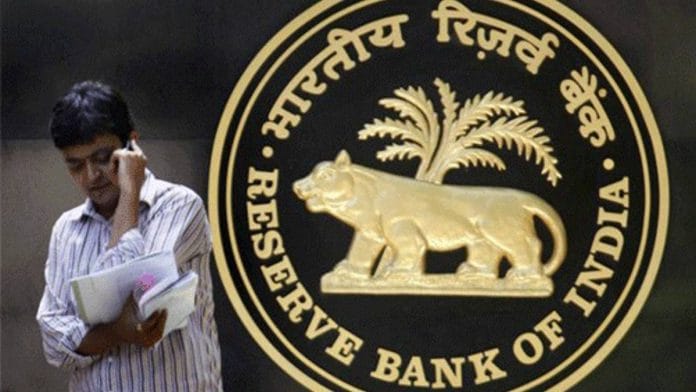New Delhi: A committee appointed by the Reserve Bank of India (RBI) has recommended several steps that banks and other financial institutions can take to reduce the Know-Your-Customer (KYC) compliance burden on customers, speed up claims processes, and enhance Unified Payments Interface (UPI) transactions.
The suggestions include expediting the process of claims by nominees of deceased customers, and applying greater discretion when categorising particular accounts as “high-risk”.
The RBI had in May 2022 set up the committee to review customer service standards in the central bank’s regulated entities (REs), which include banks, non-banking financial companies (NBFCs) and regional rural banks, among others.
The central bank Monday made public the committee’s report and invited public comments on it until 7 July 2023.
The terms of reference for the committee — headed by former RBI deputy governor B.P. Kanungo — were to evaluate and review in the regulated entities the quality of customer service, examine the evolving needs, identify the best practices and suggest measures for bringing improvements in service and grievance redressal mechanisms.
Also Read: RBI ban on 3rd-party loan recovery agents not a fix. It’s like AP’s microfinance ban mistake
Re-evaluate risk identification
The committee found that many banks and other financial institutions used a broad-brush approach when classifying particular accounts as “high-risk”, which was subjecting customers who had uniform levels of income and expenditure to the same level of scrutiny as customers with complex business ownership structures.
“The committee observed that some REs classify customers with ‘high net worth’ or all ‘walk-in customers’ as high-risk and follow uniform processes for monitoring of all customers within that risk profile, putting diverse individual customers to the same rigour as, say, customers with complex business ownership structures, even if the customer may have been a highly-paid executive with uniform pattern of inflows and outflows consistent with her profile,” the panel’s report stated.
Such a “simplistic linear identification” may result in mis-classification of risk and also inconvenience individuals, especially in case of salary-earners, it added.
In order to rectify this, the committee recommended that REs adopt a more nuanced approach to risk identification.
“For example, salary-earners with inflows and outflows consistent with the customer’s profile need not necessarily be categorised as high-risk, even though they may be ‘high net worth’ individuals,” the report said. “Similarly, students can also be categorised as low-risk.”
The existing rules are such that REs are required to categorise customers as low-, medium- and high-risk, based on the assessment and risk perception of the RE on parameters such as customer’s identity, social/financial status, nature of business activity and information about the customer’s business and their location.
Based on this classification, the REs have to then adopt a risk-based approach with respect to the periodic updation of KYC.
Ease burden on nominees
The report pointed out that, during the committee’s interactions with stakeholders, it came across several cases of hardship where nominees or legal heirs had faced significant trouble in closing accounts held by deceased deposit-holders in banks.
It added that a large number of accounts did not have a designated nominee, while also noting that simply having a nominee did not mean that the claims process was trouble-free.
“Difficulties are faced even in accounts where nominations had been made by the deceased account-holders,” the report said. “While specific instructions relating to the procedure to be adopted for settlement of claims in respect of deceased depositors have been laid down, these are not always followed.”
Further, the committee found that, even when nominations had been made, banks were found to be insisting on submission of “unnecessary” documents, for example, an undertaking to indemnify the bank in case of any legal dispute arising in the future or succession certificates, etc., which are specially prohibited by regulation.
The committee also observed that, even when the requisite documents are submitted, the bank branch is sometimes not empowered to release claims beyond a limit and so cases are required to be referred to controlling offices, and even the bank’s head office, resulting in avoidable delays.
“Obtaining nomination in deposit accounts may be made mandatory to facilitate hassle-free settlement of claims in case of death of the account-holder,” the committee recommended. “The REs should be asked to obtain nominations in all such cases within a reasonable time period, say three years.”
Further, the committee recommended that the process for settling claims related to accounts of deceased customers also be made available online, which would allow for the submission of all the required documents and verification.
“The claims may be settled within a reasonable time period, say 30 days from the date of submission of all necessary documents,” the committee added. “The timeframe should also apply when the claims are physically submitted.”
Beyond 30 days, the committee suggested that REs be required to pay interest at a rate 2 per cent higher than the one at which the deceased person’s deposit was held.
No limit on UPI transactions
The committee noted that payments through UPI were gaining popularity, and that UPI was largely being used for small value payments, something that should be encouraged.
“Currently, banks limit the debits in saving accounts,” it said. “In order to give a fillip to digital transactions, the committee recommends… the transactions undertaken through UPI may be kept outside the stipulated limits on debit transactions in saving bank accounts, including Basic Savings Bank Deposit Accounts.”
In other words, the committee suggested removing limits on the number of UPI transactions that can be done from an account.
(Edited by Nida Fatima Siddiqui)
Also Read: Bank credit has bounced back, but rising interest rates & inflation can be new hurdles






